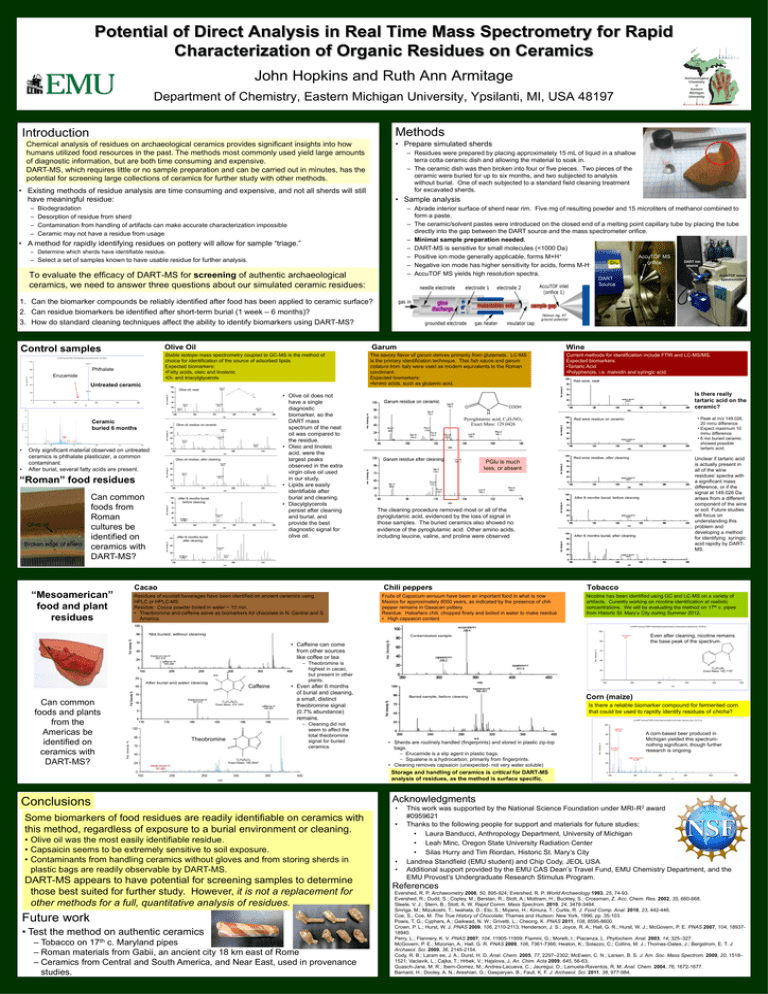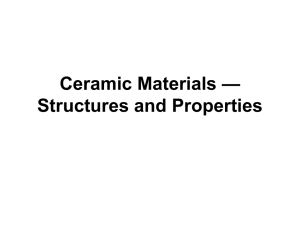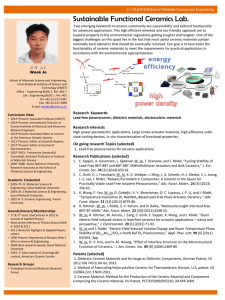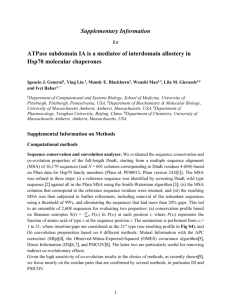
Potential of Direct Analysis in Real Time Mass Spectrometry for Rapid
Characterization of Organic Residues on Ceramics
John Hopkins and Ruth Ann Armitage
Department of Chemistry, Eastern Michigan University, Ypsilanti, MI, USA 48197
Methods
Introduction
• Prepare simulated sherds
Chemical analysis of residues on archaeological ceramics provides significant insights into how
humans utilized food resources in the past. The methods most commonly used yield large amounts
of diagnostic information, but are both time consuming and expensive.
DART-MS, which requires little or no sample preparation and can be carried out in minutes, has the
potential for screening large collections of ceramics for further study with other methods.
– Residues were prepared by placing approximately 15 mL of liquid in a shallow
terra cotta ceramic dish and allowing the material to soak in.
– The ceramic dish was then broken into four or five pieces. Two pieces of the
ceramic were buried for up to six months, and two subjected to analysis
without burial. One of each subjected to a standard field cleaning treatment
for excavated sherds.
• Existing methods of residue analysis are time consuming and expensive, and not all sherds will still
have meaningful residue:
–
–
–
–
• Sample analysis
– Abrade interior surface of sherd near rim. Five mg of resulting powder and 15 microliters of methanol combined to
form a paste.
– The ceramic/solvent pastes were introduced on the closed end of a melting point capillary tube by placing the tube
directly into the gap between the DART source and the mass spectrometer orifice.
– Minimal sample preparation needed.
b
– DART-MS is sensitive for small molecules (<1000 Da)
– Positive ion mode generally applicable, forms M+H+
– Negative ion mode has higher sensitivity for acids, forms M-H– AccuTOF MS yields high resolution spectra.
Biodegradation
Desorption of residue from sherd
Contamination from handling of artifacts can make accurate characterization impossible
Ceramic may not have a residue from usage
• A method for rapidly identifying residues on pottery will allow for sample “triage.”
– Determine which sherds have identifiable residue.
– Select a set of samples known to have usable residue for further analysis.
To evaluate the efficacy of DART-MS for screening of authentic archaeological
ceramics, we need to answer three questions about our simulated ceramic residues:
1. Can the biomarker compounds be reliably identified after food has been applied to ceramic surface?
2. Can residue biomarkers be identified after short-term burial (1 week – 6 months)?
3. How do standard cleaning techniques affect the ability to identify biomarkers using DART-MS?
Olive Oil
Control samples
Stable isotope mass spectrometry coupled to GC-MS is the method of
choice for identification of the source of adsorbed lipids
Expected biomarkers:
•Fatty acids, oleic and linolenic
•Di- and triacylglycerols
H:\DART backup\TSSPro files\Data\blank sherd positive2 Scan_323-328.txt
110
419.311
Phthalate
Rel. Intensity %
88
Erucamide
66
Garum
Untreated ceramic
44
• Olive oil does not
have a single
diagnostic
biomarker, so the
DART mass
spectrum of the neat
oil was compared to
the residue.
• Oleic and linoleic
acid, were the
largest peaks
observed in the extra
virgin olive oil used
in our study.
• Lipids are easily
identifiable after
burial and cleaning.
• Diacylglycerols
persist after cleaning
and burial, and
provide the best
diagnostic signal for
olive oil.
0
0
160
320
480
640
800
m/z
Ceramic
buried 6 months
O
HO
•
The savory flavor of garum derives primarily from glutamate. LC-MS
is the primary identification technique. Thai fish sauce and garum
colatura from Italy were used as modern equivalents to the Roman
condiment.
Expected biomarkers:
•Amino acids, such as glutamic acid.
Current methods for identification include FTIR and LC-MS/MS.
Expected biomarkers:
•Tartaric Acid
•Polyphenols, i.e. malvidin and syringic acid.
420.311
22
•
Wine
Only significant material observed on untreated
ceramics is phthalate plasticizer, a common
contaminant.
After burial, several fatty acids are present.
“Roman” food residues
Can common
foods from
Roman
cultures be
identified on
ceramics with
DART-MS?
“Mesoamerican”
food and plant
residues
Cacao
O
N
H
COOH
• Peak at m/z 149.026,
20 mmu difference
• Expect maximum 10
mmu difference
• 6 mo buried ceramic
showed possible
tartaric acid.
Pyroglutamic acid, C5H7NO3
Exact Mass: 129.0426
Unclear if tartaric acid
is actually present in
all of the wine
residues’ spectra with
a significant mass
difference, or if the
signal at 149.026 Da
arises from a different
component of the wine
or soil. Future studies
will focus on
understanding this
problem and
developing a method
for identifying syringic
acid rapidly by DARTMS.
PGlu is much
less, or absent
The cleaning procedure removed most or all of the
pyroglutamic acid, evidenced by the loss of signal in
those samples. The buried ceramics also showed no
evidence of the pyroglutamic acid. Other amino acids,
including leucine, valine, and proline were observed
Chili peppers
Residues of xocolatl beverages have been identified on ancient ceramics using
HPLC or HPLC-MS
Residue: Cocoa powder boiled in water ~ 10 min.
• Theobromine and caffeine serve as biomarkers for chocolate in N. Central and S.
America.
Is there really
tartaric acid on the
ceramic?
Fruits of Capsicum annuum have been an important food in what is now
Mexico for approximately 8000 years, as indicated by the presence of chili
pepper remains in Oaxacan pottery.
Residue: Habañero chili, chopped finely and boiled in water to make residue
• High capsaicin content
Tobacco
Nicotine has been identified using GC and LC-MS on a variety of
artifacts. Curently working on nicotine identification at realistic
concentrations. We will be evaluating the method on 17th c. pipes
from Historic St. Mary’s City during Summer 2012.
H:\DART backup\TSSPro files\Data\residues\tobacco sherd pwd scrubbed Scan_65-66.txt
120
Even after cleaning, nicotine remains
the base peak of the spectrum.
nicotine+H
163.1
96
– Theobromine is
highest in cacao,
but present in other
plants.
N
N
Caffeine
Can common
foods and plants
from the
Americas be
identified on
ceramics with
DART-MS?
N
N
C15H18N8O4
Exact Mass: 374.1451
O
N
Theobromine
HN
O
N
N
C 7 H 8 N 4O 2
Exact Mass: 180.0647
Some biomarkers of food residues are readily identifiable on ceramics with
this method, regardless of exposure to a burial environment or cleaning.
• Olive oil was the most easily identifiable residue.
• Capsaicin seems to be extremely sensitive to soil exposure.
• Contaminants from handling ceramics without gloves and from storing sherds in
plastic bags
are readily observable by DART-MS.
Future
work
DART-MS appears to have potential for screening samples to determine
those best suited for further study. However, it is not a replacement for
other methods for a full, quantitative analysis of residues.
Future work
• Test the method on authentic ceramics
– Tobacco on 17th c. Maryland pipes
– Roman materials from Gabii, an ancient city 18 km east of Rome
– Ceramics from Central and South America, and Near East, used in provenance
studies.
48
C10H14N2
Exact Mass: 162.1157
24
0
100
180
260
340
420
500
m/z
Corn (maize)
Is there a reliable biomarker compound for fermented corn
that could be used to rapidly identify residues of chicha?
H:\DART backup\TSSPro files\Data\residues\chicha beer neat pos Scan_32-51.txt
120
maltol+H
127.043
A corn-based beer produced in
Michigan yielded this spectrumnothing significant, though further
research is ongoing.
96
• Sherds are routinely handled (fingerprints) and stored in plastic zip-top
bags.
– Erucamide is a slip agent in plastic bags.
– Squalene is a hydrocarbon; primarily from fingerprints.
• Cleaning removes capsaicin (unexpected- not very water soluble)
Storage and handling of ceramics is critical for DART-MS
analysis of residues, as the method is surface specific.
Conclusions
N
N
• Even after 6 months
of burial and cleaning,
a small, distinct
theobromine signal
(0.7% abundance)
remains.
– Cleaning did not
seem to affect the
total theobromine
signal for buried
ceramics.
72
Rel. Intensity %
O
O
Rel. Intensity %
• Caffeine can come
from other sources
like coffee or tea
72
proline+H
116.077
48
sugar alcohols+H
183.088
24
0
100
180
260
340
420
500
m/z
Acknowledgments
•
•
•
•
This work was supported by the National Science Foundation under MRI-R2 award
#0959621
Thanks to the following people for support and materials for future studies:
• Laura Banducci, Anthropology Department, University of Michigan
• Leah Minc, Oregon State University Radiation Center
• Silas Hurry and Tim Riordan, Historic St. Mary’s City
Landrea Standfield (EMU student) and Chip Cody, JEOL USA
Additional support provided by the EMU CAS Dean’s Travel Fund, EMU Chemistry Department, and the
EMU Provost’s Undergraduate Research Stimulus Program.
References
Evershed, R. P. Archaeometry 2008, 50, 895-924; Evershed, R. P. World Archaeology 1993, 25, 74-93.
Evershed, R.; Dudd, S.; Copley, M.; Berstan, R.; Stott, A.; Mottram, H.; Buckley, S.; Crossman, Z. Acc. Chem. Res. 2002, 35, 660-668.
Steele, V. J.; Stern, B.; Stott, A. W. Rapid Comm. Mass Spectrom. 2010, 24, 3478-3484.
Smriga, M.; Mizukoshi, T.; Iwahata, D.; Eto, S.; Miyano, H.; Kimura, T.; Curtis, R. J. Food Comp. Anal. 2010, 23, 442-446.
Coe, S.; Coe, M. The True History of Chocolate; Thames and Hudson: New York, 1996; pp. 35-103.
Powis, T. G.; Cyphers, A.; Gaikwad, N. W.; Grivetti, L.; Cheong, K. PNAS 2011, 108, 8595-8600.
Crown, P. L.; Hurst, W. J. PNAS 2009, 106, 2110-2113; Henderson, J. S.; Joyce, R. A.; Hall, G. R.; Hurst, W. J.; McGovern, P. E. PNAS 2007, 104, 1893718940.
Perry, L.; Flannery, K. V. PNAS 2007, 104, 11905-11909; Flamini, G.; Morelli, I.; Piacenza, L. Phytochem. Anal. 2003, 14, 325–327.
McGovern, P. E.; Mizorian, A.; Hall, G. R. PNAS 2009, 106, 7361-7366; Heaton, K.; Solazzo, C.; Collins, M. J.; Thomas-Oates, J.; Bergstrom, E. T. J.
Archaeol. Sci. 2009, 36, 2145-2154.
Cody, R. B.; Laram ee, J. A.; Durst, H. D. Anal. Chem. 2005, 77, 2297–2302; McEwen, C. N.; Larsen, B. S. J. Am. Soc. Mass Spectrom. 2009, 20, 1518–
1521; Vaclavik, L.; Cajka, T.; Hrbek, V.; Hajslova, J. An. Chim. Acta 2009, 645, 56-63;
Guasch-Jane, M. R.; Ibern-Gomez, M.; Andres-Lacueva, C.; Jauregui, O.; Lamuela-Raventos, R. M. Anal. Chem. 2004, 76, 1672-1677.
Barnard, H.; Dooley, A. N.; Areshian, G.; Gasparyan, B.; Faull, K. F. J. Archaeol. Sci. 2011, 38, 977-984.








